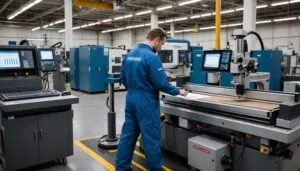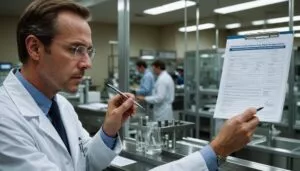To prevent manufacturing equipment deviations, you’ll need these seven essential strategies: implement risk-based preventive maintenance, establish robust qualification protocols with clear acceptance criteria, develop thorough SOPs, create environmental monitoring systems, train operators on technical skills and error recognition, deploy real-time performance analytics, and build cross-functional equipment management teams. These approaches will minimize costly downtime and quality issues while strengthening regulatory compliance. The following strategies reveal exactly how to put these concepts into action.
Key Takeaways
Contents
- 1 Key Takeaways
- 2 Implement Risk-Based Preventive Maintenance Programs
- 3 Establish Robust Equipment Qualification Protocols
- 4 Develop Comprehensive Standard Operating Procedures
- 5 Create Environmental Monitoring Systems
- 6 Train Operators on Technical Competencies and Error Recognition
- 7 Deploy Real-Time Performance Analytics
- 8 Build Cross-Functional Equipment Management Teams
- 9 Frequently Asked Questions
- 9.1 How Do Manufacturers Calculate ROI for Deviation Prevention Investments?
- 9.2 When Should Equipment Be Replaced Versus Continuing Preventive Maintenance?
- 9.3 How Do Regulatory Standards for Equipment Deviation Vary Internationally?
- 9.4 Can AI Predict Equipment Deviations Before Conventional Monitoring Systems?
- 9.5 What Insurance Considerations Apply to Equipment Deviation Risks?
- 10 Conclusion
- Implement risk-based preventive maintenance programs focusing on critical components with high failure potential.
- Establish clear equipment qualification with measurable acceptance criteria and pass/fail thresholds.
- Deploy real-time monitoring systems with automated alerts when parameters drift toward specification boundaries.
- Develop comprehensive operator training programs including simulation-based practice for error prevention.
- Form cross-functional equipment management teams with shared accountability for performance oversight.
Implement Risk-Based Preventive Maintenance Programs
When manufacturing equipment fails to meet specifications, it can lead to costly production delays and quality issues. Implementing a risk-based preventive maintenance program is your first line of defense against equipment deviations.
Start by conducting a thorough risk assessment of your manufacturing equipment. Identify critical components that pose the highest risk of failure and would cause significant disruption if they malfunction.
Then, develop a maintenance scheduling system that prioritizes these high-risk assets. You’ll want to track equipment performance data continuously to refine your maintenance intervals.
Don’t fall into the trap of fixed schedules—adjust your maintenance timing based on actual equipment condition and operating hours. This approach guarantees you’re addressing potential issues before they cause deviations while optimizing maintenance resources and minimizing unnecessary equipment downtime.
Establish Robust Equipment Qualification Protocols
Establishing robust equipment qualification protocols starts with clearly defining your acceptance criteria that align with critical quality attributes and process parameters.
You’ll need to implement stringent change control procedures to document any modifications, upgrades or repairs that could affect equipment performance.
Your installation qualification parameters should verify that all components, utilities, and safety features meet specifications and regulatory requirements before proceeding to operational qualification.
Define Equipment Acceptance Criteria
Before manufacturing equipment can be deployed in production environments, robust acceptance criteria must be defined through thorough qualification protocols.
You’ll need to establish clear equipment standards that align with your production requirements and regulatory expectations.
Develop quantitative acceptance metrics that objectively measure equipment performance against predetermined thresholds.
These criteria should cover critical aspects including accuracy, precision, speed, reliability, and compliance with safety standards.
Each parameter requires specific pass/fail criteria with appropriate tolerance ranges.
Document these criteria formally in your qualification master plan, ensuring they’re measurable, achievable, and directly linked to process capabilities.
Remember to include both static parameters (physical dimensions, material compatibility) and dynamic performance metrics (cycle times, output consistency).
Well-defined acceptance criteria prevent ambiguity during equipment assessment and provide a clear framework for identifying potential deviations before they impact production.
Document Change Control Procedures
Effective change control procedures form the backbone of equipment qualification protocols, ensuring modifications don’t compromise validated states.
You’ll need to implement systematic document versioning that tracks every alteration to equipment specifications, calibration requirements, and operational parameters.
Establish a formal change approval workflow that requires technical review, impact assessment, and sign-off from quality, engineering, and operations stakeholders. This prevents unauthorized modifications that could introduce deviation risks.
Your protocols should clearly define:
- Change classification categories (minor/major)
- Required documentation updates
- Revalidation requirements
- Implementation timelines
- Training needs
Validate Installation Qualification Parameters
Installation qualification parameters serve as the bedrock for your equipment deviation prevention strategy, extending beyond document control into physical validation.
You’ll need to establish measurable criteria for confirming that your equipment meets manufacturer specifications and regulatory requirements before operation begins.
When validating installation qualification parameters, focus on:
- Verifying utility connections match equipment specifications (electrical loads, water pressure, gas flow rates)
- Confirming physical installation dimensions and clearances against engineering drawings
- Documenting calibration status of all measurement instruments integrated with the equipment
- Testing safety features and emergency systems under controlled conditions
Thorough qualification parameters enable you to detect potential deviation sources before they impact production.
The installation validation process creates traceability between your equipment’s physical state and documented requirements, establishing a reliable baseline for ongoing performance monitoring and maintenance protocols.
Develop Comprehensive Standard Operating Procedures
Thorough Standard Operating Procedures (SOPs) form the backbone of any successful manufacturing equipment deviation prevention program.
When crafting your SOPs, you’ll need to establish clear, step-by-step instructions that operators can consistently follow. Effective SOP development requires input from experienced personnel who understand equipment nuances and potential failure points.
Ensure procedure consistency by implementing standardized formatting across all documentation. Include detailed equipment startup and shutdown sequences, troubleshooting guides, and maintenance schedules.
You should also incorporate visual aids like diagrams or photos that clarify complex processes.
Review and update your SOPs regularly as equipment modifications occur or when you identify new deviation risks. Train your staff thoroughly on these procedures and test their comprehension through practical demonstrations.
Create Environmental Monitoring Systems
You’ll need robust real-time condition tracking to immediately identify environmental shifts that could compromise production quality.
Your temperature control protocols should establish clear thresholds and automated response mechanisms to maintain ideal processing conditions.
Implementing advanced contaminant detection systems will help you identify airborne particles, moisture variations, and other environmental factors before they impact your manufacturing equipment performance.
Real-Time Condition Tracking
To effectively prevent manufacturing equipment deviations, real-time condition tracking serves as the cornerstone of proactive maintenance strategies.
You’ll need to implement thorough sensor integration across critical machinery components to continuously monitor performance parameters and detect anomalies before they cause failures.
Data visualization platforms transform complex equipment data into actionable insights through intuitive dashboards that your team can quickly interpret and respond to.
- Configure automated alerts that notify technicians when parameters exceed predefined thresholds
- Implement trending analysis to identify gradual degradation patterns before they become critical
- Utilize wireless monitoring technologies to track hard-to-reach components
- Integrate mobile access capabilities so your maintenance team can respond to issues from anywhere
This real-time visibility empowers you to make data-driven decisions that extend equipment life and minimize costly downtime.
Temperature Control Protocols
Temperature fluctuations within manufacturing environments can trigger equipment malfunctions and product quality deviations when left unmonitored. You’ll need robust temperature calibration methods to maintain ideal operating conditions for your equipment.
| Protocol Component | Implementation Strategy | Benefits |
|---|---|---|
| Thermal mapping techniques | Deploy heat-mapping sensors at critical points | Identifies hot/cold spots requiring intervention |
| Calibration schedule | Establish quarterly verification protocols | Guarantees measurement accuracy and consistency |
| Alarm parameters | Set deviation thresholds with automated alerts | Provides immediate notification of excursions |
Implement these protocols by installing networked thermocouples throughout your facility. You’ll capture real-time data while establishing historical temperature profiles for trend analysis. When you detect anomalies, initiate corrective actions before equipment performance degrades, preventing costly downtime and quality issues.
Contaminant Detection Systems
Contaminants that infiltrate manufacturing environments can severely compromise equipment reliability and product integrity if not detected promptly.
You’ll need to implement thorough monitoring systems with sensor integration across critical points in your production facility to identify contamination sources before they cause equipment deviations.
- Deploy particulate monitoring systems that can detect airborne contaminants at sizes relevant to your specific manufacturing processes
- Install fluid analysis sensors to continuously monitor hydraulic systems and coolants for metal fragments that indicate equipment wear
- Implement vision systems with AI capabilities to identify visual contamination on product surfaces during production
- Utilize IoT-connected moisture and chemical sensors strategically positioned to alert you to environmental changes that could introduce contaminants
Train Operators on Technical Competencies and Error Recognition
Developing a technically proficient workforce stands at the core of any effective deviation prevention strategy.
You’ll need thorough training programs that enhance operator skill while simultaneously building error awareness. Make certain your operators understand not just how to run equipment, but why specific procedures exist and what failure modes look like.
Implement simulation-based training where operators can safely make mistakes and learn from them without production consequences.
Regular competency assessments will help you identify knowledge gaps before they manifest as deviations. Consider pairing less experienced staff with seasoned mentors who can demonstrate proper techniques and subtle warning signs.
When operators recognize potential issues before they escalate, you’ll see dramatic reductions in equipment deviations.
Their enhanced technical acumen transforms them from equipment users into your first line of defense against manufacturing problems.
Deploy Real-Time Performance Analytics
While operators provide critical human oversight, real-time performance analytics deliver the continuous visibility needed to catch deviations before they impact product quality.
You’ll gain immediate insights into process variables through data visualization tools that transform complex metrics into actionable intelligence.
- Implement dashboards showing real-time comparisons against performance benchmarks
- Set up automated alerts when parameters drift toward specification boundaries
- Utilize pattern recognition algorithms to identify subtle deviation trends
- Deploy statistical process control charts visible to all stakeholders
Build Cross-Functional Equipment Management Teams
Real-time data alone can’t break down organizational silos that often contribute to equipment issues.
You’ll need to establish cross-functional equipment management teams that bring together maintenance technicians, operators, process engineers, and quality specialists to collaboratively address deviations before they escalate.
When you create these teams, focus on skill alignment that leverages each member’s expertise. Engineers understand design limitations, operators recognize subtle performance changes, and maintenance staff can identify deterioration patterns.
This collaborative approach guarantees thorough equipment oversight while fostering shared accountability.
Schedule regular team huddles to review performance metrics, recent incidents, and near-misses. Empower your teams to implement preventive actions without excessive bureaucracy.
You’ll find that these cross-functional partnerships not only reduce equipment failures but also accelerate problem-solving and improve knowledge transfer across departments.
Frequently Asked Questions
How Do Manufacturers Calculate ROI for Deviation Prevention Investments?
You’ll calculate ROI for deviation prevention by tracking cost analysis metrics like reduced defects, downtime, and waste against your initial investment. Compare these investment metrics to baseline performance.
When Should Equipment Be Replaced Versus Continuing Preventive Maintenance?
You should replace equipment when repair costs exceed 50% of replacement value or when maintenance frequency increases dramatically. Consider downtime losses, reliability trends, and established replacement criteria.
How Do Regulatory Standards for Equipment Deviation Vary Internationally?
You’ll find regulatory compliance varies considerably across regions. Different countries enforce their own international standards with varying strictness, inspection frequencies, and documentation requirements for equipment deviations.
Can AI Predict Equipment Deviations Before Conventional Monitoring Systems?
Yes, AI can predict equipment deviations through predictive analytics and machine learning before your conventional systems detect issues, giving you valuable time for preventive maintenance interventions.
What Insurance Considerations Apply to Equipment Deviation Risks?
You’ll need specialized liability coverage that addresses equipment failure risks. Conduct thorough risk assessments to negotiate better premiums and guarantee you’re adequately protected against potential deviation-related losses.
Conclusion
You’ll see immediate improvements when you integrate these seven strategies into your manufacturing operations. By focusing on preventive measures rather than reactive fixes, you’re creating a culture of excellence that minimizes deviations before they occur. Remember that equipment reliability isn’t just about machinery—it’s about the systems, people, and processes surrounding it. Make these approaches standard practice, and you’ll transform your production reliability for years to come.



